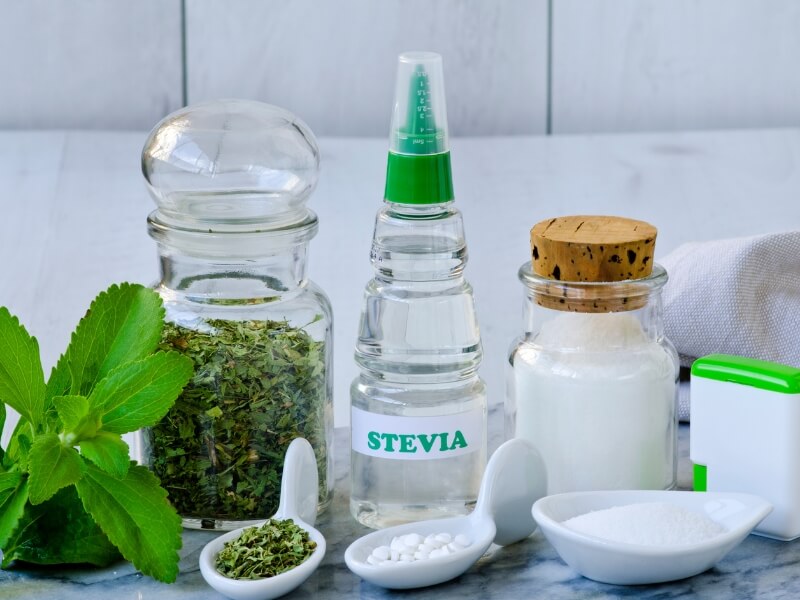Stevia Glycemic Index, Glycemic Load, and Blood Sugar Response Chart

Based on
Blood Glucose Response Chart
Stevia has a Glycemic Index (GI) of 0 and a Glycemic Load (GL) of 0 (per 100g).
Unlike traditional sweeteners, stevia does not impact blood glucose levels as its steviol glycosides pass through the body without being metabolized into glucose. Stevia glycosides are also metabolized without requiring insulin. This makes stevia a safe sugar alternative for individuals managing diabetes or blood sugar control.
Stevia, a plant-derived natural sweetener, has gained global popularity for its zero-calorie and blood sugar-friendly properties. With an increasing focus on sugar alternatives, understanding stevia's effects on Glycemic Index (GI), Glycemic Load (GL), and blood sugar response is essential.
This article explains why stevia has a GI and GL of zero, how it interacts with metabolism, and why it is a preferred sweetener for those managing diabetes, insulin resistance, and metabolic health.
Stevia's Zero Glycemic Impact Explained
Stevia contains natural sweet compounds called steviol glycosides (stevioside, rebaudioside A). These pass through the digestive system without breaking down into glucose.
- Gut Microbiota Breakdown
In the colon, gut bacteria hydrolyze steviol glycosides into steviol. Unlike sugar, this process does not produce glucose or raise blood sugar levels. - Absorption and Metabolism
Steviol is absorbed into the bloodstream and transported to the liver. The liver conjugates steviol into steviol glucuronide, which is then excreted via urine without affecting insulin levels.
Stevia Does Not Require Insulin for Metabolism
Stevia glycosides are metabolized without requiring insulin involvement, making them suitable for people with insulin-related disorders. The body processes these natural sweeteners through non-insulin-dependent pathways in the digestive system.
The metabolism of stevia compounds occurs primarily through a unique pathway that operates independently of insulin. When consumed, steviol glycosides (the sweet compounds in stevia) travel through the upper gastrointestinal tract without being broken down. This initial phase requires no insulin interaction.
In the lower intestine, gut bacteria break down the steviol glycosides into steviol through hydrolysis. This bacterial degradation process is completely separate from insulin-mediated pathways. The resulting steviol is then absorbed into the bloodstream and processed by the liver, where it undergoes glucuronidation (a detoxification process) before being excreted primarily through urine.
This insulin-independent metabolic pathway is particularly significant because it:
- Doesn't trigger insulin release from the pancreas
- Doesn't require insulin for cellular uptake
- Doesn't interfere with blood glucose regulation mechanisms
This metabolic independence from insulin makes stevia particularly valuable for individuals with diabetes or insulin resistance, as their bodies can process stevia normally even when insulin function is impaired.
Stevia Does Not Convert Into Glucose or Contribute to Post-meal Blood Sugar Spikes
Stevia, a natural zero-calorie sweetener, does not get metabolized into glucose or affect post-meal blood sugar levels.
Research has consistently shown that consuming stevia doesn't trigger the typical post-meal blood sugar spike associated with regular sweeteners. This is particularly significant because post-meal blood sugar spikes can contribute to various health issues, including insulin resistance and Type 2 diabetes over time. When stevia is used in beverages or foods, it provides sweetness without the corresponding glucose surge that typically follows sugar consumption.
Stevia has a Glycemic Index of zero, meaning it doesn't cause any measurable rise in blood glucose levels. This is in stark contrast to table sugar (sucrose), which has a Glycemic Index of 65 and rapidly converts to glucose during digestion. Even when consumed as part of a larger meal, stevia doesn't contribute to the meal's overall Glycemic Load or influence how other carbohydrates in the meal are processed.
Unlike sugar, stevia doesn't stimulate insulin secretion from the pancreas. This is crucial for maintaining stable blood sugar levels after meals, as excessive insulin responses can lead to blood sugar fluctuations and potential metabolic issues over time. The absence of an insulin response makes stevia particularly valuable for individuals who need to manage their blood sugar levels carefully.
Stevia is a low-GI Sweetener
Stevia is a powerful natural alternative to sugar, with a Glycemic Index and Glycemic Load of zero. Unlike artificial sweeteners, it has a natural origin, supports stable blood sugar levels, and is backed by scientific evidence.
Key Takeaways:
- Stevia’s GI and GL are 0, making it ideal for diabetes and metabolic health.
- It does not convert into glucose and does not stimulate insulin secretion.
- Studies confirm it is safe and effective for long-term use.
- It is calorie-free, non-toxic, and a better alternative to sugar.
For those looking to reduce sugar intake while maintaining a healthy metabolism, stevia is one of the best choices available today.